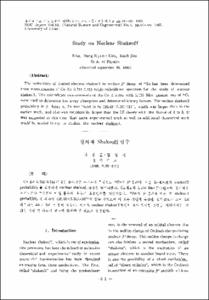난소종양에서 초음파를 이용한 형태지수에 관한 예비적 연구
- Alternative Title
- Preliminary Study of a Morphology Index using Ultrasonography in Ovarian Tumors
- Abstract
- To evaluate the usefulness of morphology index using ultrasonography for differentiating benign from malignant ovarian tumors, 36 patients with ovarian tumors were examined from March, 1993 to June, 1993. Thirty patients were premenopausal and 6 patients were postmenopausal. Transabdominal sonographic pelvic images of 36 patients were correlated with histopathology. Of 38 ovaries, 31 had benign tumors (6 mucinous cystadenoma, 7 endometrial cyst, 7 mature cystic teratoma, 3 corpus luteal cyst, 1 parovarian cyst, 1 fibroma, 1 simple cyst) and 7 had malignant tumors.
Mean morphology index(MMI±SE) of malignant ovarian tumors, 9.42±0.97 was significantly higher than that of benign ovarian tumors, 4.51±0.36 (P<0.0001).
In premenopausal patients, mean morphology index(MMI±SE) of benign and malignant ovarian tumors was 4.44±0.37, and 9.33±1.45, respectively. In postmenopausal patients, the MMI was 5.5±1.5 for benign ovarian tumors and 9.5±1.5 for malignant tumors. In both premenopausal and premenopausal women, there were no ovarian malignancies in tumors with morphology index below 6.
This scoring system was useful in distinguishing benign from malignant tumors(specificity 74% and sensitivity 100%). Our result is more sensitive but somewhat less specific than the others. The main source of false positive results were mucinous cystadenoma and mature cystic teratoma, because of large tumor volume and solid 멗. This study is going on with combined use of color Doppler and tumor markers and the further results will be presented.
To evaluate the usefulness of morphology index using ultrasonography for differentiating benign from malignant ovarian tumors, 36 patients with ovarian tumors were examined from March, 1993 to June, 1993. Thirty patients were premenopausal and 6 patients were postmenopausal. Transabdominal sonographic pelvic images of 36 patients were correlated with histopathology. Of 38 ovaries, 31 had benign tumors (6 mucinous cystadenoma, 7 endometrial cyst, 7 mature cystic teratoma, 3 corpus luteal cyst, 1 parovarian cyst, 1 fibroma, 1 simple cyst) and 7 had malignant tumors.
Mean morphology index(MMI±SE) of malignant ovarian tumors, 9.42±0.97 was significantly higher than that of benign ovarian tumors, 4.51±0.36 (P<0.0001).
In premenopausal patients, mean morphology index(MMI±SE) of benign and malignant ovarian tumors was 4.44±0.37, and 9.33±1.45, respectively. In postmenopausal patients, the MMI was 5.5±1.5 for benign ovarian tumors and 9.5±1.5 for malignant tumors. In both premenopausal and premenopausal women, there were no ovarian malignancies in tumors with morphology index below 6.
This scoring system was useful in distinguishing benign from malignant tumors(specificity 74% and sensitivity 100%). Our result is more sensitive but somewhat less specific than the others. The main source of false positive results were mucinous cystadenoma and mature cystic teratoma, because of large tumor volume and solid 멗. This study is going on with combined use of color Doppler and tumor markers and the further results will be presented.
- Issued Date
- 1993
- Type
- Research Laboratory
- Alternative Author(s)
- Nam,Joo Hyun; Cho,Yoon Kyung; Kim,Young Tak; Mok,Jung Eun
- Publisher
- 울산의대학술지
- Language
- kor
- Rights
- 울산대학교 저작물은 저작권에 의해 보호받습니다.
- Citation Volume
- 2
- Citation Number
- 1
- Citation Start Page
- 27
- Citation End Page
- 33
- Appears in Collections:
- Research Laboratory > The ULSAN university medical journal
- 파일 목록
-
-
Download
 000002025569.pdf
기타 데이터 / 345.8 kB / Adobe PDF
000002025569.pdf
기타 데이터 / 345.8 kB / Adobe PDF
-
Items in Repository are protected by copyright, with all rights reserved, unless otherwise indicated.